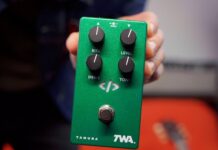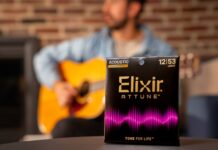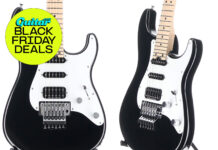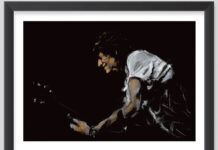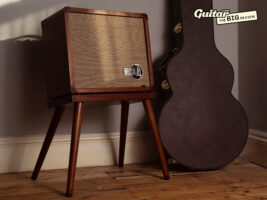
Taylor Circa 74 Koa review: “Brings a touch of aesthetic class to an intimate acoustic context”
$1,599/£1,845, taylorguitars.com
In recent years the acoustic amp scene has split neatly in two directions. On the one hand we have industrial looking units from AER, Fishman and Trace Elliott with rugged solid-state power stages, metal grilles and military grade rubber corners for the street-fighting acoustic musician. On the other hand we have exotic wood units such as the legendary (and legendarily priced) tube-based work of Humphrey amps (and recent collaboration with Henrickson) which are as close to a Frank Lloyd Wright staircase as they are to a guitar amp.
READ MORE: Taylor 314ce Studio review: “Forget where the neck is made, this is every bit the US-made instrument”
Coming straight into the middle of those two worlds is the Circa 74: Taylor’s first-ever acoustic amplifier. It’s a solid-state amp, but designed to appeal to the sort of player who sees amplification as an aesthetic lifestyle choice – without the three grand pricetag of some other furniture-adjacent acoustic boxes. Seen here in a gently figured Hawai’ian Koa (a mahogany version is $400 cheaper) it’s a good looking box that will bring the room together nicely between your Noguchi coffee table and Eames Lounge Chair.
Image: Adam Gasson
Taylor Circa 74: What is it?
You’ll notice that Circa 74 doesn’t say Taylor anywhere on it – that’s because it’s technically a sub-brand all of its own. It’s a similar situation to the recent Powers Electric guitars created by Taylor CEO Andy Powers.
For Circa 74, this time it’s Bob Taylor’s turn for a side project. The story goes that he wanted to put a stash of wood unsuitable for guitar making to better use, and so roped in pro player Terry Myers, electronics guru Tyler Robertson and woodworking wizard David Judd to help him design an amp.
Stories like that are the sizzle not the steak of course, so we’ll avoid going into any more detail than that and concentrate on the sounds and functionality on offer in this debut product instead.
Image: Adam Gasson
Taylor Circa 74: In use
One of the challenges with acoustic guitar amplification is the instrument’s comparatively wide and complex frequency spectrum. This means that even a dedicated acoustic combo will often be relegated to duty as a stage monitor or abandoned entirely in favour of the stereo spread of a PA system. Really, does anyone actually need an acoustic amp?
In an appeal to versatility, the Circa 74 has two channels, each with its own EQ and reverb controls. There’s a master volume, input A has an XLR/guitar lead input but there is no 48v phantom power here though, so it’s dynamic mics only. Input B is guitar lead only – an understandable choice perhaps, but it feels like a missed opportunity to get ahead of the competition with potential for stereo mic use.
All outward appearances suggest that this amp will likely spend its life providing a gentle push to a solo or duo performance rather than dimed as part of a serious on-stage set-up. The absence of notch or phase filter buttons or a foot switchable mute all point to home/coffeeshop use as its primary stomping ground, as well as presupposing the use of an instrument with its own controls. There is, however, a choice of XLR or line outs if you do need to go big, and are not using in-ears.
The controls are based around a three-band EQ – no surgical parametric frequency sculpture here. There is one room reverb choice for both channels and you get to choose how much of it you want. That’s it.
There is, however, an aux mini jack-in and Bluetooth functionality, so you can listen to music or play along. It also comes with a gentle angled wooden stand for improved projection and, let’s not kid ourselves, because it looks nice.
Image: Adam Gasson
Taylor Circa 74: Sounds
Despite the fact that this is a Taylor amp, I cue up my Casimi C1 signature model with an internal K&K passive pickup to give the Circa 74 its first run through. Helpfully Taylor does include some guidance (just scan the QR code on the back) to help you find a workable sound with a variety of different pickups, but personally I’d rather spend a moment twiddling knobs to learn how the EQ bands interact – in tone there are no shortcuts.
With all controls at noon we have enough push to fill a small room. Raising the volume further does bring up the matter of positioning. If I sit too close then I’m in danger of spiralling off into feedback – too far away and the sound gets a little cloudy, and in larger rooms I’d be worried about things getting mushy; especially with added reverb.
The Circa 74 features a single 10” speaker. That’s it. Mono. No tweeters, no acoustic ports. As such any sense of spread is once again at the mercy of the room. The harder you push it the more noticeable this becomes.
In standard tuning the amp handles things as well as I’d hope with a clear top-end sizzle. Does the wooden body make any sonic difference? Possibly, but that’s beside the point. I know the plugged-in voice of my guitar reasonably well and this is a decent fingerstyle sound – if not as immediately responsive as I’m used to.
A good test of any acoustic amp is the way it handles drop tunings. While the Circa 74 was reasonably happy in DADGAD – go any lower and things begin to get unruly. Once we start entering Orkney/Drop C territory then the combination of soundboard sensitivity and a lack of parametric EQ means that an indistinct bottom end is all but inevitable.
Image: Adam Gasson
Taylor Circa 74: Should I buy one?
The question, as is often the case with acoustic guitar amps, is who exactly this amp is for – and with the Circa 74 it’s certainly a layered one.
The most serious solo acoustic guitarist on steel or nylon strings is very likely to be using a hybrid two-output pickup system, which would take up both channels, removing the possibility of using a mic for talking to the audience.
A singer-songwriter who is fine using dynamic mics only while strumming along might find this serves their needs for smaller gigs. Likewise for a guitarist/singer duo this might well be the very thing. Interestingly this is a really great amp for a clean jazz archtop sound. Which is a nice bonus.
Chances are, you’ll know as soon as you see the Circa 74 if you want one. And if you do then the chances are your expectations are likely to match the intent with which it was originally designed. Complaining that it doesn’t shake the rafters or is too genteel to be lugged around from venue to venue is rather like lamenting the off-road capabilities of a Jaguar E-Type.
What this amp does very well is bring a touch of aesthetic class to an intimate acoustic context. It is streamlined and easy to use (the glaring oversight of a lack of phantom power notwithstanding) and looks good wherever you put it. Like a modern phonogram – joyfully anachronistic, completely impractical and a lot of fun.
Taylor Circa 74 amp: Alternatives
It’s certainly not going to win any beauty contests compared with the Circa 74, but the Fishman Loudbox Performer BT ($930/£849) dominates the mid-price end of the acoustic amp market, and in truth there’s not a lot occupying the space between the Fishman and the big beasts of AER’s Acousticube 3 ($3,299/£2,999) at the top end of the market. It could well be that this is a niche where they can make some hay…
The post Taylor Circa 74 Koa review: “Brings a touch of aesthetic class to an intimate acoustic context” appeared first on Guitar.com | All Things Guitar.
Source: www.guitar-bass.net


